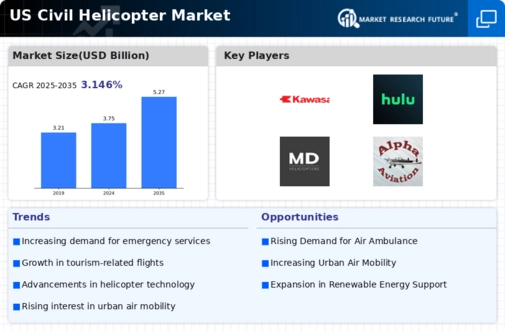Advancements in Safety Regulations
Advancements in safety regulations are significantly impacting the civil helicopter market. Regulatory bodies, such as the FAA, continuously update safety standards to enhance operational safety and reliability. These regulations often lead to the adoption of advanced technologies, such as collision avoidance systems and enhanced pilot training programs. The implementation of stricter safety measures is likely to instill greater confidence among operators and passengers, potentially increasing the overall demand for civil helicopters. Furthermore, as safety becomes a paramount concern for both operators and customers, the civil helicopter market may see a growth rate of 4-6% as compliance with these regulations becomes a competitive advantage.
Increased Demand for Emergency Services
The civil helicopter market experiences a notable surge in demand for emergency medical services (EMS). Helicopters are increasingly utilized for rapid patient transport, particularly in remote or inaccessible areas. The National Association of State EMS Officials indicates that approximately 450,000 patients are transported annually by air ambulances in the US. This trend is likely to continue, driven by the need for timely medical interventions. Furthermore, the integration of advanced medical equipment in helicopters enhances their utility in emergency situations, thereby solidifying their role in the civil helicopter market. As the population ages and healthcare needs grow, the demand for EMS helicopters is expected to rise, potentially leading to a market growth rate of 5-7% over the next few years.
Government Investments in Infrastructure
Government investments in infrastructure development play a crucial role in shaping the civil helicopter market. Federal and state initiatives aimed at improving transportation networks often include provisions for helicopter landing zones and support facilities. The Federal Aviation Administration (FAA) has allocated significant funding for infrastructure projects that enhance helicopter operations, particularly in urban areas. This investment is likely to facilitate the growth of the civil helicopter market by improving accessibility and operational efficiency. Additionally, as urban areas expand, the need for efficient transportation solutions becomes more pressing, potentially leading to increased demand for civil helicopters. Analysts suggest that this trend could result in a market growth rate of 3-5% in the coming years.
Rising Interest in Aerial Work Applications
The civil helicopter market is witnessing a rising interest in aerial work applications, including utility inspections, firefighting, and agricultural services. Helicopters are increasingly employed for tasks that require precision and accessibility, such as power line inspections and crop monitoring. The US Energy Information Administration reports that the demand for aerial inspections in the energy sector is projected to grow by 6% annually. This trend is likely driven by the need for efficient and timely operations in various industries. As companies recognize the advantages of using helicopters for specialized tasks, the civil helicopter market may experience a corresponding increase in demand, potentially leading to a growth rate of 5-8% over the next few years.
Expansion of Tourism and Sightseeing Operations
The civil helicopter market is significantly influenced by the expansion of tourism and sightseeing operations. Helicopter tours offer unique aerial perspectives of popular destinations, attracting both domestic and international tourists. According to the Helicopter Association International, the tourism sector accounts for a substantial portion of helicopter operations, with revenues exceeding $1 billion annually in the US. This growth is likely fueled by the increasing popularity of adventure tourism and the desire for unique experiences. As more companies enter the market, competition may drive innovation and service diversification, further enhancing the appeal of helicopter tours. Consequently, this trend could contribute to a projected growth rate of 4-6% in the civil helicopter market over the next few years.

















Leave a Comment